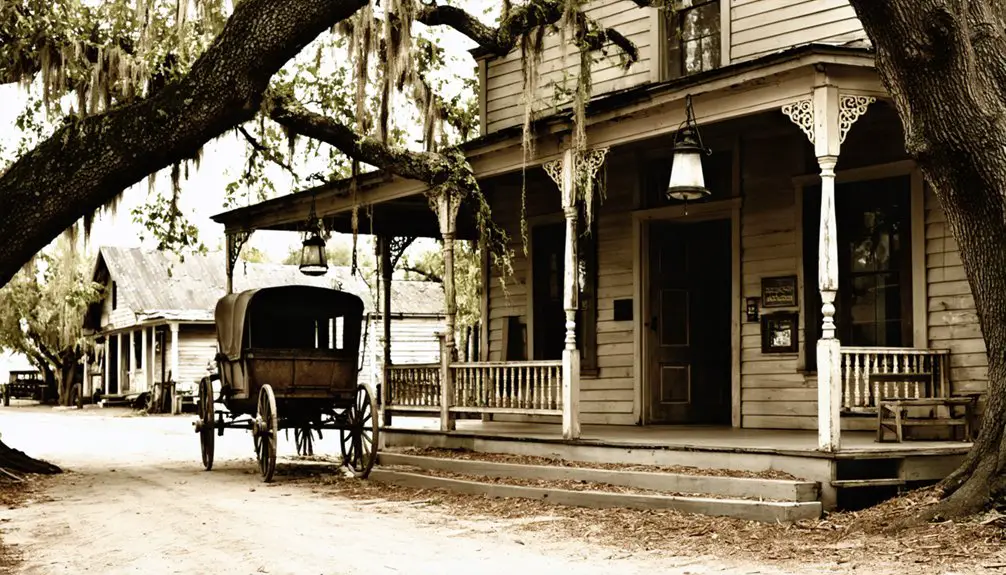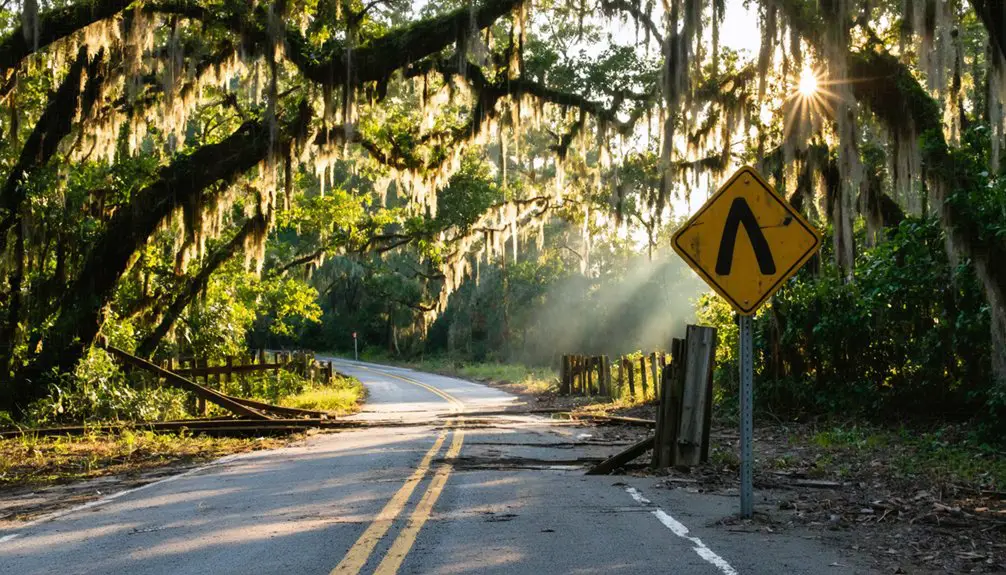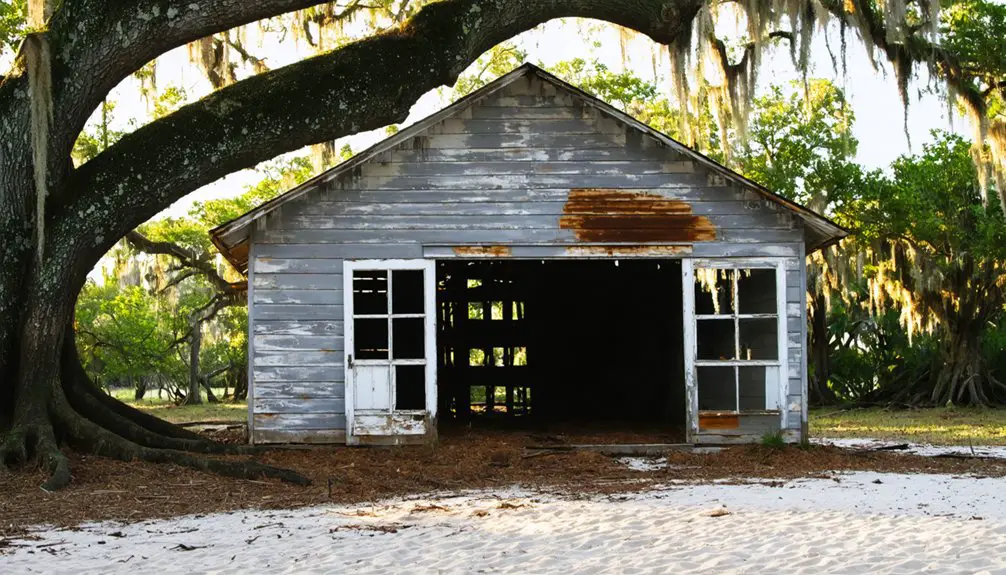You’ll find Verna’s ghost town legacy in Florida’s early 20th-century turpentine industry. Originally named St. Claire, the town was established in 1925 and named after John Posey’s daughter, serving as a hub for local farming and pine sap extraction. Despite generating significant wealth through turpentine production, the economic downturn of 1926 led to Verna’s dissolution by 1929. Today, archaeological surveys and artifact recovery efforts continue uncovering the town’s rich frontier story.
Key Takeaways
- Verna was established in 1925 as a Florida town centered around turpentine production but dissolved by 1929 due to economic downturn.
- The town straddled Manatee and Sarasota counties, serving as a hub for local farming communities and turpentine industry workers.
- Transportation challenges, including the 1921 relocation of the Atlantic Coast Line depot, contributed significantly to Verna’s decline.
- Archaeological surveys continue to uncover artifacts like household items and tools, preserving evidence of the abandoned town’s history.
- Originally named St. Claire, the town was renamed to Verna after John Posey’s daughter when it was officially incorporated.
From St. Claire to Verna: The Origins
While the exact date remains unclear, Verna, Florida began its existence as St. Claire, a small settlement positioned at what would become a significant intersection of major roadways.
St. Claire’s importance stemmed from its strategic location and role as a hub for local farming communities, reflecting the agricultural focus of early Florida settlements. Much like the pineapple plantations that thrived in neighboring areas during the late 1800s, the region supported various agricultural ventures. The area featured a general store similar to the one that operated in the historic Whaley House.
Verna’s renaming coincided with its incorporation as a city, marking a pivotal shift in the community’s identity.
You’ll find the town’s development followed patterns similar to other Florida settlements of the era, with Scandinavian communities like Viking establishing themselves nearby.
The intersection of State Route 70, Verna Bethany, and Verna Roads remains a reflection of the town’s original placement, though the once-thriving community would later face challenges that would transform it into the ghost town you’ll discover today.
The Turpentine Industry’s Golden Age
You’ll discover that Verna’s turpentine operations, like many across Florida in the early 1900s, relied on the “cup and gutter” method to extract valuable pine sap for naval stores production. Workers collected sap in terracotta or tin cups mounted on trees.
Workers often found themselves trapped in a cycle of debt through payment in company store scrip. During this golden age, the industry generated significant wealth for companies like Knabb while simultaneously depending on controversial forced labor practices, primarily affecting African American men who faced harsh working conditions in the camps.
The economic boom transformed small settlements like Verna into bustling industrial hubs, though this prosperity came at considerable human and environmental cost as pine forests were systematically tapped and later sold to logging companies.
During the turpentine industry’s golden age, naval store production methods evolved into a sophisticated system of harvesting and processing pine resin.
You’d find workers using the cup method for turpentine extraction, which allowed longleaf pines to survive the tapping process, making it a more sustainable harvesting approach until the trees were eventually depleted.
The process was remarkably efficient, though labor-intensive. You could expect a 50-gallon batch of pine sap to yield about 325 pounds of pitch and tar, plus 10 gallons of liquid turpentine.
Workers would boil the collected sap in large kettles equipped with copper coil systems, known as worms, which separated the turpentine spirits from the resin. Workers were often paid in company store scrip, creating a cycle of dependency on their employers.
The innovative Herty Cup design revolutionized resin collection methods by improving both efficiency and sustainability in the industry.
These products were then shipped worldwide, meeting the growing global demand for naval stores.
Economic Impact On Florida
As Florida’s turpentine industry reached its zenith, the economic impact rippled throughout the state’s economy, generating approximately $43 million in income for over 8,000 producers by mid-20th century – equivalent to about $57,000 per producer in 2018 dollars.
You’ll find the industry’s influence extended far beyond direct production. Turpentine exports became a crucial component of Florida’s forest products sector, which later reached $1.8 billion in international trade. The southeastern United States dominated global turpentine production during this period.
The labor market thrived as the industry directly employed thousands, with forest-related jobs becoming the backbone of many rural communities. In counties like Verna, turpentine production created essential employment opportunities and supported numerous ancillary businesses, from transportation to wood preservation.
This economic engine helped finance infrastructure improvements and drove regional development throughout Florida’s rural landscape.
Worker Life And Labor
Behind the economic prosperity of Florida’s turpentine industry lay a stark reality of labor exploitation and harsh working conditions. You’d find primarily African American workers, including freedmen and convicts, toiling in remote camps deep within the pine forests.
Daily hardships included dangerous tree-tapping work, exposure to toxic turpentine vapors, and grueling hours managing boiling kettles of pine sap. Workers faced a system designed to trap them through debt, with payment often made in goods rather than cash at inflated camp store prices.
Local sheriffs, in league with politically connected camp owners like Thomas Jefferson Knabb, funneled prisoners into what amounted to forced labor. Despite the skilled nature of turpentine work, which required precise knowledge of pine anatomy and processing techniques, workers endured near-slavery conditions with minimal legal protections or recourse. The camp’s digital asset collections now preserve photographic evidence of these harsh working conditions and labor exploitation practices.
John Posey’s Vision and Legacy
John Posey’s grand vision for Verna emerged during Florida’s 1920s real estate boom, when he and his business partner Frank Golden advertised ambitious plans for new neighborhoods including Verna Heights, La Verna, and Verna Courts.
You’ll find that Posey’s dream of transforming his daughter’s namesake town into a thriving community was cut short by the 1926 Florida economic downturn, which halted development and led to the town’s dissolution by 1929.
Though Verna’s official status was brief, Posey’s legacy lives on through local landmarks like Verna Bethany Road and his documented role as a pioneering figure in the region’s early development. The town once featured a bustling post office and hotel before becoming a ghost town after the stock market crash. Today, modern digital collections help preserve the history of ghost towns like Verna for future generations to study and explore.
Founder’s Ambitious Town Plans
During the Florida real estate boom of the 1920s, ambitious plans for Verna’s expansion took shape through landowner John Posey’s partnership with Frank Golden and Bradenton developers.
Their urban planning vision included new residential neighborhoods like Verna Heights, La Verna, and Verna Courts, with advertisements running in newspapers from Tampa to Miami.
You’ll find Posey’s real estate aspirations reflected in his extensive infrastructure plans, which called for a post office, school, grocery store, restaurant, and hotel.
He incorporated Verna as an official town in June 1925, renaming it from St. Claire to honor his daughter. The boundary encompassed parts of both Manatee and Sarasota counties, showcasing Posey’s regional development mindset.
Unfortunately, Florida’s 1926 economic downturn derailed these grand plans, leading to the town’s dissolution by 1929.
Father’s Lasting Namesake Legacy
A dedicated public servant’s influence continues to echo through Manatee County’s history, as records show Deputy Clerk John Posey‘s lasting impact on local governance and development.
You’ll find Posey’s contributions woven throughout the region’s infrastructure projects, particularly in his support of railroad expansion that helped shape Southwest Florida’s economic landscape.
His role in judicial administration established essential frameworks for legal documentation and property records, while his precise record-keeping standards strengthened community stability.
Through archived collections and historical narratives, you can trace how Posey’s legacy in community governance helped foster the growth of small settlements like Verna.
Today, his story serves as a reflection of how civic officials shaped the cultural heritage of Florida’s ghost towns.
Life in Early 20th Century Verna

Life in early 20th century Verna centered around the bustling turpentine industry, which drew workers from Georgia and the Carolinas to this remote Florida settlement.
Despite being larger than nearby Myakka, the community faced significant challenges due to its isolation, including limited access to essential services and resources.
Your daily experience in Verna would have included:
- Working in the piney woods, extracting valuable turpentine from the abundant pine trees that dominated the landscape.
- Participating in agricultural practices alongside neighbors in a close-knit community where survival depended on mutual support.
- Adapting to a diverse social environment where African American workers from the Southeast worked alongside a smaller number of white laborers, all sharing the struggles of frontier life.
The town’s remote location meant you’d have to be self-reliant while maintaining strong bonds with your fellow settlers.
Economic Rise and Industrial Development
Verna’s economic foundation emerged from Florida’s rich natural resources, building upon the town’s early social framework as a frontier settlement.
You’d find the town’s industries following typical boom-and-bust cycles, from sawmilling and turpentine production to farming ventures in citrus and watermelons. Resource depletion often triggered these industrial fluctuations, as lumber stocks dwindled and agricultural markets shifted.
Local enterprises like River’s Grocery and Post Office served as essential commercial hubs for nearly a century, while seasonal agriculture provided steady income between resource-based booms.
Small businesses anchored Verna’s commerce, while farming helped sustain the community through cycles of resource-driven prosperity.
The town’s development attracted land speculators who invested in infrastructure, though their ventures frequently proved unsustainable. As natural resources vanished and transportation patterns changed, Verna’s industrial base gradually eroded, mirroring the fate of many Florida frontier towns.
Transportation Routes and Regional Connections

Through its strategic railroad connections, the frontier town gained fundamental access to Florida’s broader transportation network via the Atlantic Coast Line Railroad in the early 1900s.
You’ll find that Verna’s transportation evolution revolved primarily around the ACL, which served as an essential lifeline for moving timber and turpentine to regional markets.
The town’s regional isolation intensified after these key developments:
- The ACL depot relocation in 1921 severely disrupted Verna’s connections to neighboring communities.
- Limited road infrastructure failed to replace the critical railroad links once they declined.
- Without direct river access, the town couldn’t pivot to waterway transportation like other Florida settlements.
This perfect storm of transportation changes ultimately contributed to Verna’s transformation from a bustling frontier town to a ghost town.
The Slow Fade: Factors Behind Abandonment
While many ghost towns fade quickly due to single catastrophic events, the abandonment of Verna unfolded as a complex interplay of economic, environmental, and demographic factors spanning several decades.
The community decline began with the devastating sawmill fire in 1898, exposing Verna’s economic vulnerability to industry-specific disasters.
You’ll find that natural disasters, particularly floods and hurricanes, repeatedly battered the town’s infrastructure and residents’ resolve.
The Great Depression accelerated the exodus, as young people sought opportunities in larger cities.
Agricultural shifts dealt another blow – smaller farms gave way to industrial operations, while soil depletion and flooding made farming increasingly difficult.
Without economic diversification or infrastructure investment, Verna’s fate was sealed through a gradual erosion of population, services, and community cohesion.
Remnants and Ruins Today

Today, nature steadily reclaims what remains of this once-thriving community, leaving only scattered fragments of its past. If you’re planning a ruins exploration of Verna, you’ll find brick roads crumbling beneath encroaching vines and abandoned staircases leading nowhere.
The dense Florida foliage has transformed residential plots into a wild, forested landscape, while seasonal flooding continues to erode structural foundations.
During artifact recovery efforts, you might discover:
- Household remnants like ceramic shards and vintage glass bottles
- Rusted tools and metal fittings embedded in wooden debris
- Old bricks with manufacturing stamps that reveal construction timelines
While unauthorized scavenging threatens these historical treasures, local historians occasionally lead guided tours to document what’s left of Verna’s vanishing heritage.
Preserving Verna’s Historical Significance
As Verna’s physical remnants fade into Florida’s wilderness, thorough preservation efforts have become a race against time.
You’ll find historical preservation initiatives focusing on gathering oral histories from descendants while securing official documentation dating back to 1914, including records of turpentine production and the town’s 1925 incorporation.
Community engagement plays an essential role through educational projects at local schools, historical tours, and partnerships with regional museums.
Local communities keep Verna’s history alive through school programs, guided tours and collaborative museum partnerships.
You can explore Verna’s story through digital mapping and interactive exhibits, while formal protections help safeguard the site from development.
Working with state preservation commissions enables grant funding for maintenance, and interpretive signage marks key locations.
Archaeological surveys and academic research continue to uncover new details about this lost Florida town.
Frequently Asked Questions
What Was the Peak Population of Verna During Its Most Prosperous Years?
Like a videogame with missing save data, you’ll find no exact population records, but historical significance suggests Verna’s peak was likely between 100-300 residents before population decline occurred.
Were There Any Churches or Schools Established in Verna?
You’ll find a school was established in Verna by the 1920s, serving local families, but church history remains unclear with no direct records of religious institutions being built in the town.
What Happened to the Residents When They Left Verna?
You’ll find Verna’s residents scattered to nearby towns seeking jobs after the 1929 crash, with many shifting to cattle ranches and citrus farms, while others moved to larger Florida cities.
Did Any Notable Events or Disasters Contribute to Verna’s Decline?
While no singular disaster marked Verna’s end, you’ll find economic downturns and regional changes caused its gradual decline. Unlike 75% of Florida ghost towns that faced natural disasters, Verna faded through slow deterioration.
Are There Any Local Legends or Ghost Stories Associated With Verna?
You won’t find documented haunted locations or ghost sightings in Verna. Historical records and research sources don’t mention any supernatural tales, and without remaining structures, there’s little foundation for local legends.
References
- https://historicarchaeology.weebly.com/journal/venus-in-florida-ghost-town-101
- https://patchproflorida.com/blog/the-fascinating-history-of-floridas-ghost-towns/
- https://www.florida-backroads-travel.com/old-venus-a-florida-ghost-town.html
- https://www.ghosttowns.com/states/fl/verna.html
- https://en.wikipedia.org/wiki/List_of_ghost_towns_in_Florida
- https://www.youtube.com/watch?v=TxBONhwNi1k
- https://www.trolleytours.com/san-diego/whaley-house
- https://mymanatee.contentdm.oclc.org/digital/collection/p16681coll2/id/12627/
- https://www.youtube.com/watch?v=kXGAKmjGMXg
- https://www.tiktok.com/@socialshepherdadventures/video/7342301852702100778



